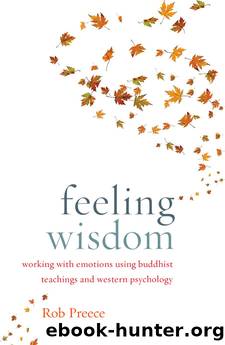Feeling Wisdom: Working with Emotions Using Buddhist Teachings and Western Psychology by Rob Preece

Author:Rob Preece [Rob Preece]
Language: eng
Format: epub
Publisher: Shambhala
Published: 2015-01-12T18:30:00+00:00
9
creating inner space
O NCE WE DEEPEN OUR capacity to meditate within the territory of sensations and feelings, together with their underlying energy/vitality, we begin to see some important aspects of our sense of self, which has two dimensions. One is a natural capacity to hold a relatively stable sense of self-identity in our relationship to the experiences of our inner and outer life. This self acts as a filter and focus for what we are going through from moment to moment, and without it we would find it extremely difficult to focus our subjective life. We would be disintegrated and scattered in relation to the events of our life. Effectively, without a sense of self, we would become extremely disoriented and psychologically unstable, potentially leading to psychosis.
Alongsideâor perhaps one could say withinâthe emergence of this healthy sense of self as we grow up, there also grows another tendency. This is a gradual solidification of self into something that feels very real, solid, and central to who we are. I say âfeelsâ because this is not an intellectual or philosophical notion of a self, a me, or an I; it is a felt âme.â Modern psychology has become increasingly clear that this process of constellating a sense of self begins very early on, even, some would say, within the womb. It is the influences of the environment as they impact the fetus and then the infant after birth that gradually mold a sense of me that seems solid and real. This, of course, is not described within Buddhist philosophy in any depth because Buddhism does not propose a developmental model.
In Buddhist philosophy a great deal of time may be spent analyzing the nature of the I, but that does not alter the fact that as we experience it, it is felt. It will, of course, have a mental component that holds on to a conception of me that has certain beliefs about itself. I recall going through hours of self-reflective introspection as an adolescent, trying to decide who or what I was, but this was not very helpful. What was happening organically, in spite of me, was the gradual establishment of my âidentity projectâ with these two dimensions of the self, one the natural relative self and the other the more emotional solid self, growing in parallel. 1 From a Buddhist point of view, these two dimensions form our self-identity or self-image, our sense of me.
What we recognize in our exploration of this phenomenon from a psychological perspective is that the felt experience of me becomes focused around a number of things. One is the sense of our body and how we feel about ourselves as body. Another is the more superficial view we have of ourselves as our self-image and self-identity grow. There is also a deeper sense of whether we feel okay about ourselves or not that grows from a very early period of development and profoundly colors our sense of self. This is the sense of me that comes up when we are hurt or upset.
Download
This site does not store any files on its server. We only index and link to content provided by other sites. Please contact the content providers to delete copyright contents if any and email us, we'll remove relevant links or contents immediately.
Through Windows of Opportunity : A Neuroaffective Approach to Child Psychotherapy by Marianne Bentzen; Susan Hart(889)
Overcoming ADHD Without Medication : A Guidebook for Parents and Teachers by Children and Natural Psychology Association for Youth; Children The Association for Youth(826)
Out of the Mainstream: Helping the Children of Parents with a Mental Illness by Loshak Rosemary;(821)
Delphi Collected Works of Sigmund Freud (Illustrated) by Sigmund Freud(580)
The Noom Mindset by Noom(555)
The 48 Laws of Mental Power: Overcoming Trauma and Building Mental Strength by Victor O. Carl(485)
The Psychology of Media and Politics by George Comstock & Erica Scharrer(451)
MANIPULATION & MIND CONTROL: The Persuasion Collection: Dark Psychology Secrets, Analyze & Influence People with Nlp. How to learn Reading Friends and Develop Body Language Skills. by ROBERT TOWER(441)
Sigmund Freud by Janet Sayers;(415)
It's nobody's fault: new hope and help for difficult children and their parents by Harold Koplewicz(406)
Behold the Monster by Jillian Lauren(404)
The Hypnotic Coach: A Conversational Hypnotherapy Tool Kit by Marion Jess(395)
Directions in Technical Writing and Communication by Gould Jay R.;(385)
THE PSYCHOLOGY OF ENTREPRENEURSHIP; New Perspectives by Michael M. Gielnik; Melissa S. Cardon; Michael Frese(360)
Mastering Flow: Perform Better, Experience More Joy, and Live a Happier Life by Nils Salzgeber(351)
Totem and Taboo: Some Points of Agreement between the Mental Lives of Savages and Neurotics by Sigmund Freud(346)
Positive Psychology Across the Lifespan; An Existential Perspective by Piers Worth(338)
Mind Hacking Secrets and Unlimited Memory Power: 2 Books in 1: Learn How to Improve Your Memory & Develop Fast, Clear Thinking in 2 Weeks + 42 Brain Training Techniques & Memory Improvement Exercises by Sharp Scott(336)
The Modern Young Man's Guide to Manhood by Wayne Walker(326)
